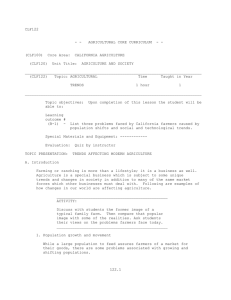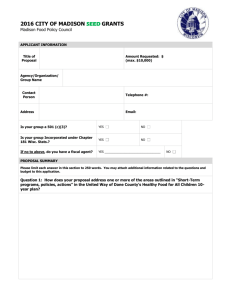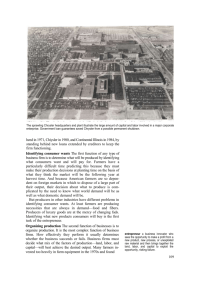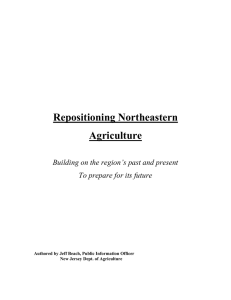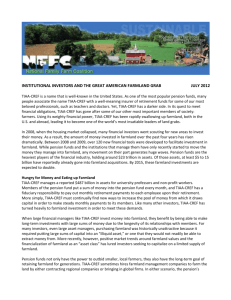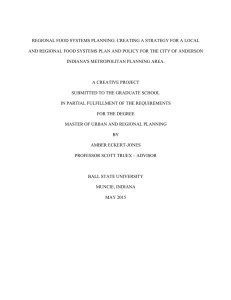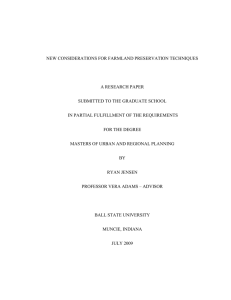Madison County Comprehensive Plan Update
advertisement
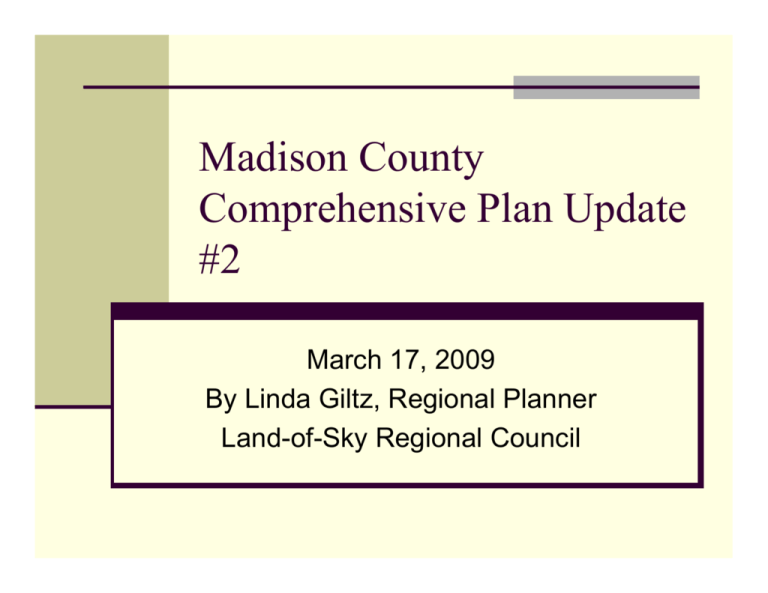
Madison County Comprehensive Plan Update #2 March 17, 2009 By Linda Giltz, Regional Planner Land-of-Sky Regional Council Purpose of a Comprehensive Plan A comprehensive plan guides development and change for a community. It provides the basis and direction for a community’s land development and land use policies and regulations. The plan examines the interrelationships between land use, transportation, utilities, the local economy, recreation, community character, etc. A comprehensive plan geographically covers the entire community and has a long time horizon, typically 10 to 20 years. It represents the interests of the citizens as a whole. The Plan – recommendations & guidance to help the County: Preserve the rural character, natural resources and scenic beauty of Madison County; Preserve agriculture and the agricultural communities; Assist and support commercial and subsistence farmers, so agriculture continues to be a vital part of the County’s economy; Identify where and what types of development occur in the county and plan for growth; Recognize emerging economic opportunities and identify the best locations for businesses/employers; Enable the development of more affordable housing options in the County; Plan for and provide services and infrastructure in more coordinated efforts with the towns; and Identify changes to current policies, procedures and ordinances to accomplish the above goals and protect public health and safety. Outline Housing Data Agriculture Chapter What’s next Housing Values & Affordability 2000 avg home sale price $173,753 2007 avg home sale price: $288,128 Median housing value (assessed value) for Madison less than NC and US $94,600 compared to $108,300 for NC and $119,600 for US Small number of high-priced homes cause average to be much higher than median Housing Characteristics 10,733 housing units in 2007 (9722 in 2000) Small amount are seasonal (7%) 18% are vacant Majority are single family homes (67%) 28% are manufactured homes Less than 5% are multifamily units 77% of homes are owner-occupied Over 40% of homes were built prior to 1970; 15% built before 1940 Housing - Questions Would it be useful to try and determine water and wastewater sources for the households in the county? What would you like to see included related to public/subsidized housing? (availability, location, etc.) Additional information related to affordability or about fair market rents? Agriculture Highlights Madison County Agriculture in 2007 Most farms are small (< 50 acres) Most farmers (60%) report something other than farming as their primary occupation Madison County Farmland Average age of farmers Percent by Type of Land Use (2007) is 58 Other, 7.3% Approx. $15 million in annual farm receipts (same as 10 years ago) Cropland, 25.8% Pasture, 30.1% Woodland, 36.3% Agriculture Highlights Lots of change over past ten or more years County losing farmland at an increasing rate – 20% lost from 1982-2002 and another 20% lost from 2002-2007 Farmers aging and retiring Skyrocketing land prices; pressure to sell Increased costs for fuel, fertilizer, feed Tobacco buyout program 2500 burley farms 10 yrs ago; now 50 Two-year drought 680 livestock farms 10 yrs ago; now 200 Agriculture and Economic Development Transition – education, new markets and distribution channels, wholesale/retail, different skill sets, agri-tourism opportunities Need for coordinated promotion and marketing of ag & related products & services Improved communication channels DIVERSITY of products and services key to success Partnerships with school system and colleges Agriculture Recommendations 1. Adopt a County policy to purchase local food and agriculture products 2. Consider infrastructure needed to support agriculture when planning for, prioritizing and funding infrastructure projects 3. Create and adopt a countywide farmland protection plan 4. Facilitate the coordination & collaboration of economic development, tourism and agricultural organizations… Agriculture Recommendations 5. Consider property tax reductions/incentives for active agricultural producers; enforce the Present Use Value PUV program 6. Review current use and promotion of the NC Homestead Exemption 7. Consider implementing land use and development policies/regulations to support and encourage agriculture 8. Provide education, training and technical assistance to farmers and future farmers Comprehensive Plan Outline 1. Introduction 2. Background Information and Trends 3. Long-term Vision for the County 4. Existing Land Use 5. Environmental Issues and Natural Resources 6. Economic Development Strategies 7. Agriculture Plan Outline (cont.) 8. Transportation System 9. Housing 10. Infrastructure / Utilities 11. Growth Management Strategies and Scenarios 12. Future Land Use Plan 13. Capital Improvements 14. Intergovernmental Coordination 15. Implementation Schedule to Complete Draft Plan Complete Draft of Chapter 2 (Background) Draft Existing Land Use Chapter (Ch. 4) Draft Agriculture Chapter (Ch. 7) Draft Economic Development Chapter (Ch. 6) Draft Housing Chapter (Ch. 9) Draft Infrastructure Chapter (Ch. 10) Draft Environmental Issues chapter (Ch. 5) Draft Transportation Chapter (Ch. 8) Draft Growth Management Chapter (Ch. 11) Draft Future Land Use Chapter (Ch. 12) Draft Capital Improvements chapter (Ch. 13) Draft Intergovernmental Coord. Chapter (Ch. 14) Draft Implementation Chapter (Ch. 15) JAN X FEB MAR X X X X X X X MAY JUNE X X X X X JULY X X X X X X X X X Steering Committee meet to review draft to date Steering Committee meet to review draft to date Update to County Commissioners APR X 3/16 2/9 x x Thank you… Questions? Comments?
